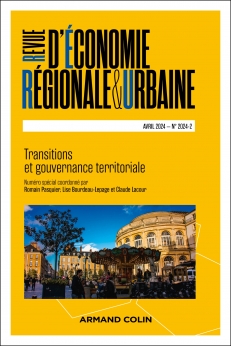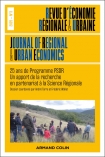
REVUE D'ÉCONOMIE RÉGIONALE ET URBAINE (2/2024)
Pour acheter ce numéro, contactez-nous
Recevez les numéros de l'année en cours et accédez à l'intégralité des articles en ligne.
Les politiques de la transition s’inscrivent-elles dans une approche d’égalité territoriale ? En analysant la distribution des fonds par quatre financeurs publics majeurs, nous souhaitons évaluer la transition écologique en termes de justice spatiale. Pour ce faire, nous mobilisons un cadre d’analyse pluridisci-plinaire, déployant des méthodes quantitatives et qualitatives. L’analyse statistique et cartographique nous permet de mettre en évidence des territoires sous-dotés et sur-dotés. Nous cherchons ensuite à identifier les déterminants quantitatifs du captage de financement, avant d’observer les facteurs locaux, de nature qualitative, qui expliquent les inégales capacités des collectivités territoriales à capter les subventions. Au final, l’article montre que la régulation politique locale apparaît cruciale pour comprendre la capacité différenciée des territoires à capter des fonds. Dès lors, l’insuffisante prise en compte de la dimension territoriale par les bailleurs de la transition empêche cette dernière d’apparaître comme un levier de lutte contre les inégalités socio-spatiales.
By analyzing how four major public funders (The French Agency for Acological Transition - ADEME, European Regional Development Fund- ERDF, the Ministry of Ecological Transition and the Occitanie Region) allocate their funds targeting ecological transition to public and private stakeholders, we assess energy transition in terms of spatial justice : do the transition policies fit into the traditional approach of territorial equality? Or do they reinforce the concentration of resources in the richest territories?Or, conversely, do they fall under the definition of spatial justice proposed by Edward Soja, which implies increased support for the least endowed territories ? To answer these questions, we mobilize a multidisciplinary analytical framework, both quantitative and qualitative. After presenting the energy transition main public funders, we analyze the spatial distribution of their funds at the scale of a French large region i.e. Occitanie. Statistical and cartographic analyses highlight under- and over-endowed territories, it also highlights inequalities of access between territories with similar characteristics. This is why we thereafter seek to identify the quantitative determinants of the distribution of funding. First we argue the norms and procedures (legal, professional, financial, organizational and political) of the project-based funding heavily weight on and frame the allocation process. These norms encourage a snowball effect : the best-endowed actors (i.e. large communalities or firms) capture most of the funding. Second, we identify few « hard » and « soft » local factors explaining the unequal capacities of local authorities to capture subsidies. The technical and a-territorial approach characterizing energy transition policies so far fails to correct existing spatial inequalities.
